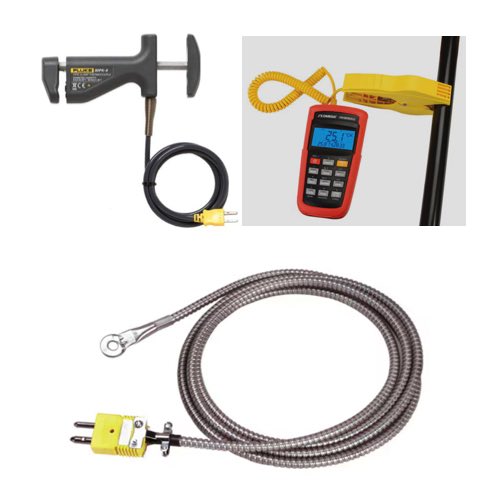
Thermocouples

Thermocouples are widely used temperature sensors that measure temperature by generating a thermoelectric voltage from the junction of two dissimilar metals. They are a preferred solution in industrial settings due to their durability, fast response times, and ability to operate across a broad temperature range. Type K and Type J thermocouples are among the most commonly used base metal thermocouples, valued for their reliability and cost-effectiveness in measuring high temperature environments like furnaces and heat treat processes.
Noble metal thermocouples such as Type S and Type R are engineered for extremely high temperatures and harsh conditions, including applications involving inert or oxidizing atmospheres. These thermocouples are constructed with thermocouple alloys that offer excellent chemical resistance and stability, even at elevated temperatures. The use of stainless steel protective sheaths and carefully selected extension wire ensures that these sensors maintain signal integrity and accuracy over long distances and in aggressive environments.
Products
More Information about Thermocouples
Thermocouples work effectively in a wide temperature range and are often chosen for their simplicity and rugged construction. The sensing junction, whether grounded or exposed, plays a critical role in determining response time and suitability for specific applications. Whether measuring surface temperature or integrating into a high-temperature process line, thermocouples like Type J and Type K offer consistent performance. Their versatility and ability to directly measure temperature differences make them ideal for many types of thermal monitoring in manufacturing, power generation, and lab settings.
FAQs
Can grounded thermocouple wires handle very high temperatures in a thermoelectric circuit?
Yes, grounded thermocouple wires can handle very high temperatures in a thermoelectric circuit, providing fast response times and reliable measurements in demanding industrial environments.
What are the temperature limits of the K thermocouple type?
The temperature limits of a Type K thermocouple typically range from −200°C to +1,260°C (−328°F to +2,300°F), making it suitable for a wide variety of industrial applications.
What is an RTD?
What is an RTD?
RTD stands for Resistance Temperature Detector. RTDs use a specific type of metal that, depending on the resistance measured in the metal, can measure temperature. Thin film element RTDs use a very thin layer of resistive metal adhered to a substrate, typically ceramic, and coated in glass or epoxy. Wire wound element RTDs provide greater accuracy and a wider temperature measurement range, however, over time the element wire can become stressed leading to slight measurement errors. Coiled element RTDs are the most common type of RTD and allow for strain free measurement on the wire element while still providing accurate measurement.
How do RTD elements work?
As the temperature of a metal increases, the metal's resistance to the flow of electricity increases. As the temperature of the RTD resistive element increases, the electrical resistance, measured in ohms, also increases. Each metal has a certain resistance measurement at different temperatures. Based on the resistance that is measured in a given type of metal, it can be determined what the temperature is. The most common types of metals used in RTDs are platinum, nickel and copper.
What are some advantages and disadvantages of RTDs?
RTDs provide a high level of accuracy over a wide operating range. Because of their accuracy, they are often used in situations where temperature measurement is critical. RTDs are rarely used at temperatures above 660 degrees Celsius and they do not provide the same level of accuracy or resolution as thermistors at lower temperatures.

